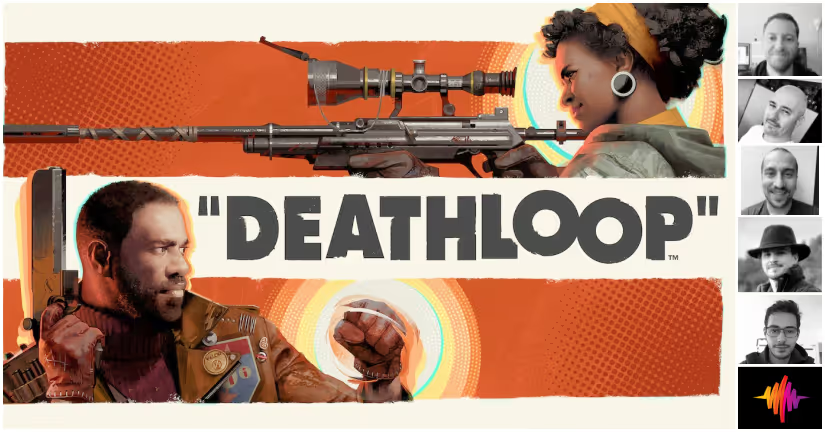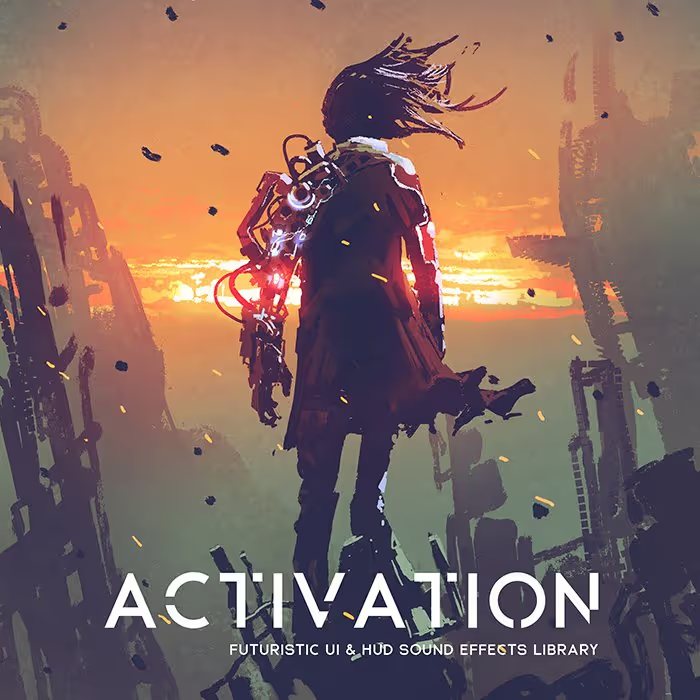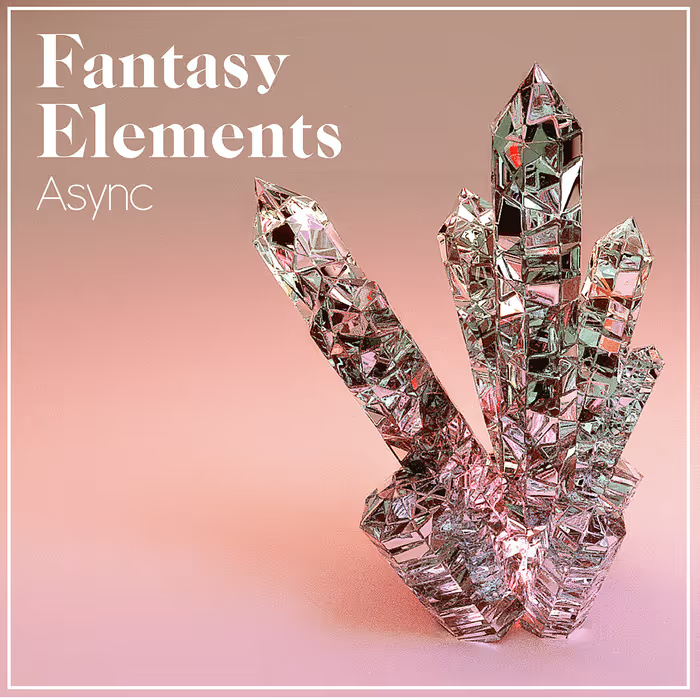Here, Audio Director Michel Trémouiller takes us through the sound team's approach to designing the game's retro '60s inspired sound. Plus, he discusses their challenges in creating sounds for a time-looped reality, designing weapons, tech, and UI sounds, creating distinct-sounding locations, handling technical and mixing challenges, and more!
Deathloop is like the video game version of Groundhog Day, only the main character is a badass assassin named Colt instead of a cynical TV weatherman named Phil Connors. Ok, maybe that comparison is a bit of a stretch. But they do both involve a time loop that requires the protagonist to repeat the same day over and over until they ‘get it right.’
Since its release in September, Deathloop (developed by Arkane Studios and published by Bethesda Softworks) has been roping in players and critics alike, earning nine nominations at The Game Awards 2021 — including one for Best Audio Design — and winning both Best Game Direction and Best Art Direction. Deathloop earned six nominations at the Golden Joystick Awards 2021, winning the Critics Choice Award.
Here, Michel Trémouiller — Audio Director on Deathloop at Arkane Studios — talks about their inspiration for the game’s retro look and sound, what a ‘time loop’ involved in terms of sound, creating distinct soundscapes for each location in the game, their approach to designing the weapons, gadgets (like the Hackamajig), and UI sounds, how they handled the stealth aspect sonically, their technical challenges, mixing challenges, and much more!
DEATHLOOP – Official Trailer
When you first started on Deathloop, did the team at Arkane Studios have specific ideas on how they wanted the game to sound overall? What was the initial direction? How did that evolve as the game was coming together?
Michel Trémouiller (MT): The initial art direction was strongly based on Tarantino’s movies. We wanted to create a colorful 60’s vibe in our game. So, we designed a kind of caricature western with a blend of vintage pop styles and we made sure that all our sound effect sources, banks, and additional in-house data suited our creative aim.
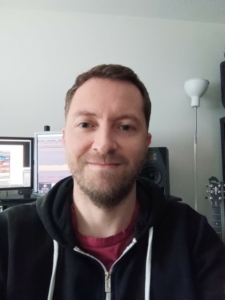
The Lost series inspired us for the game’s quiet environments and for rusty metal environmental ambiences. Old James Bond movies like Only Live Twice with its array of devices and weapons, were also one of our main influences for the game’s gadgets and mechanisms.
In addition, from the start of the conception, Blackreef’s huge central antenna was a key element both for game design and for the art direction, so we kept that focus in mind for all the equipment sounds on the island. This in turn led to the distortion and sound glitches that can be heard throughout the game, which we discovered would become central to defining our game’s audio identity.
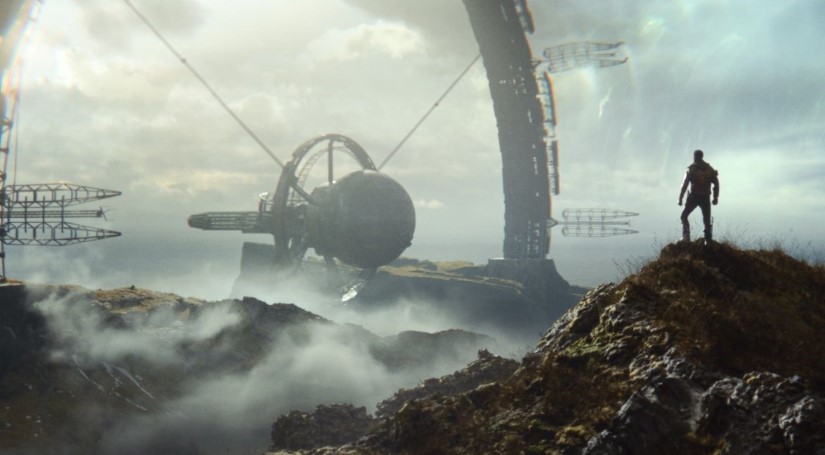
Players are stuck in a time loop until they kill the all eight Visionaries. What did this mean for you in terms of sound, for reusing assets and creating new assets for each new loop?
MT: The loop did not really impact us in terms of reuse of sounds, but more about the nature of the sound itself, as all game elements corresponding to the time loop events are related to the island anomalies. Whether these are caused by Blackeef island’s huge antenna or a more mysterious force like the “residuum” (kind of like Dishonored’s Void), we created a paranormal sound layer mixed with a technological-based one (radio sounds, glitches, electrical hums), and added that into a lot of sounds linked to the loop aspects of the gameplay (UI during time transition, power and ability use, etc.).

By the way, there are several audio points in the game that refer directly to the time notion and the idea of the loop. For instance, Thomas Mitton (Senior Sound Designer, the same person who managed the audio of the Dishonored games!) used sounds of vintage cassette players and rewinding tapes to support Colt’s rewind after his death, when he dies and comes back to a point in time a few minutes before. We used many sounds from disc and tape handling in Deathloop to evoke time, its accelerations, and slowing down.
Clock sounds are also used extensively for the various mechanisms and gadgets, and are a subconscious reminder of the importance of time throughout the game.
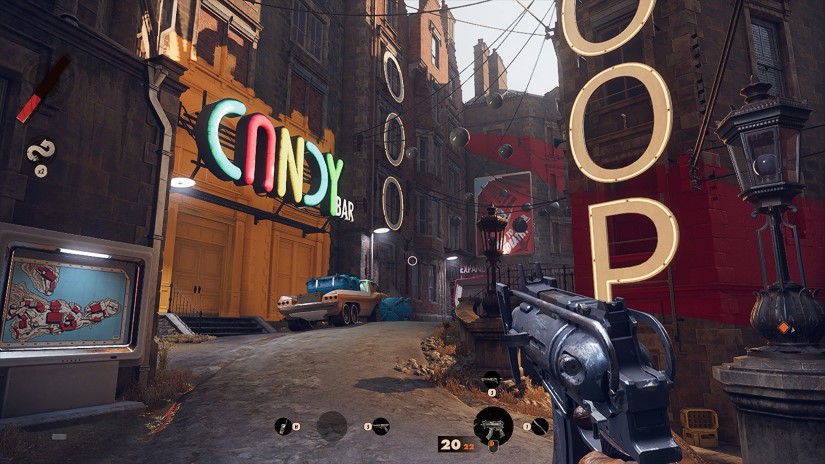
There are four different districts in the game: Updaam, Karl’s Bay, Fristad Rock, and The Complex. What are some of the sonic distinctions for each area?
MT: Of course, each environment has its own characteristic sound ambiences depending on its topology: The Complex with its central huge antenna and giant, rusty metal structures, and Fristad Rock surrounded by an ever-present frozen sea, etc. But Blackreef mainly remains an island with basic and classical elements, with its water, rocky reefs, ice, and its omnipresent wind so we needed other ways to give some audio variety.

For this purpose, we used the specific distractions that can be found in each map to help create unique audio identities: the carnival activities in Karl’s Bay with their music jingles everywhere and the mechanical sounds of automatons, Frank Spicer’s radio show broadcast everywhere via street speakers in Fristad Rock, and a guitarist playing on the top of a van in a car junkyard of The Complex (Grégory Desmurs, our Senior Guitar Heroes Sound Designer in real life).
In Updaam, the mood is very different depending on the time of the day — workers and soldiers patrol in the morning, whereas the night features a concert with dynamic music and dancing people, for example. Here, it is obviously the NPCs that create the specific ambience of the environment, much like a real city, in fact.
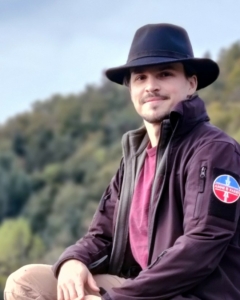
In addition, each area has a common evolution of its ambience, corresponding to the time period of the loop sequence: morning = quiet, evening = fast, and night = wind and snow. This helped Artists and Sound Designers to bring variety within the same environment.
Finally, the sound of Blackreef’s central antenna is one of the most important markers for each environment of Blackreef. This iconic sound made by Fabien Goury (Tech and Sound Designer) is a pulsing blast that is more or less present across the island and that varies according to your distance from it and the time of the day. After a few hours in the game, we still perceive it but do not really pay attention anymore. However, it still is a very good indicator of the zone where the player is.
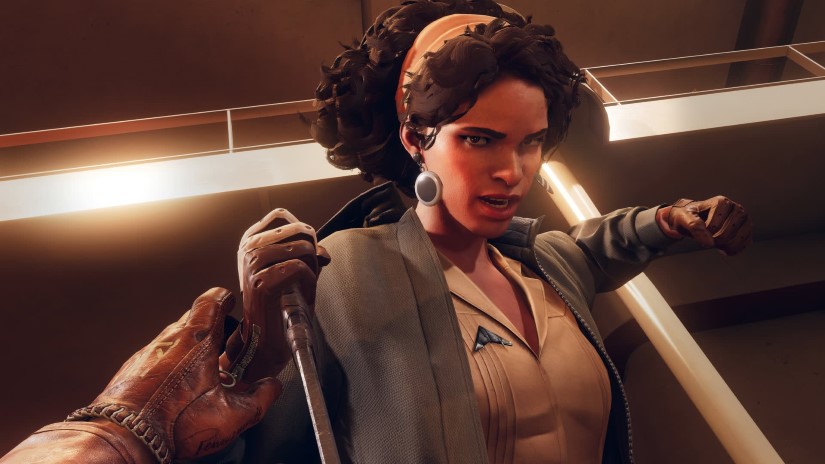
Deathloop is set in the 1960s. How did you incorporate that into the aesthetic of your sound work? For instance, did you use more analog/outboard gear for processing sounds? Or, did you worldize recordings/voices through vintage speakers? (I love the PA announcements sound. It’s so grimey! And I love the slap delay, too).
MT: We’ve taken many paths to support the 1960’s color on our sounds. One of which is the basic audio signals used for anything that is ringing and other feedback beeps (grenades, buttons, etc.). Plus, we use a lot of radio sounds for interactives, like Colt’s gadgets. This gives a retro spy movie feel to many of the player’s interactions. We recorded the sound of many old mechanisms and buttons for this.
We can also talk about all the diegetic music that we did a lot of post-processing on to add distortions, glitches, and a pitch bend effect with LFO to simulate the inconstant playback speed of the old tape players.
Hear the original score for Deathloop below:
Convolutions, EQ, distortion, and delay are the main effects that we used as DSP.
Moreover, we are also really satisfied by the post-processes that are all applied in real-time via our audio engine. Convolutions, EQ, distortion, and delay are the main effects that we used as DSP. This method allowed us to automatically apply a convincing sound rendering to street speakers, radios, the “2-BIT” Robot, and various other loudspeakers. We did this for all localized languages at the same time. This method also provided more agility and iteration options to our great Narrative Design Team.
 Tesla Model X 2015 electric full size crossover SUV sport utility vehicleKrampfstadt Studio65,00 $0,00 $100% OFF
Tesla Model X 2015 electric full size crossover SUV sport utility vehicleKrampfstadt Studio65,00 $0,00 $100% OFF
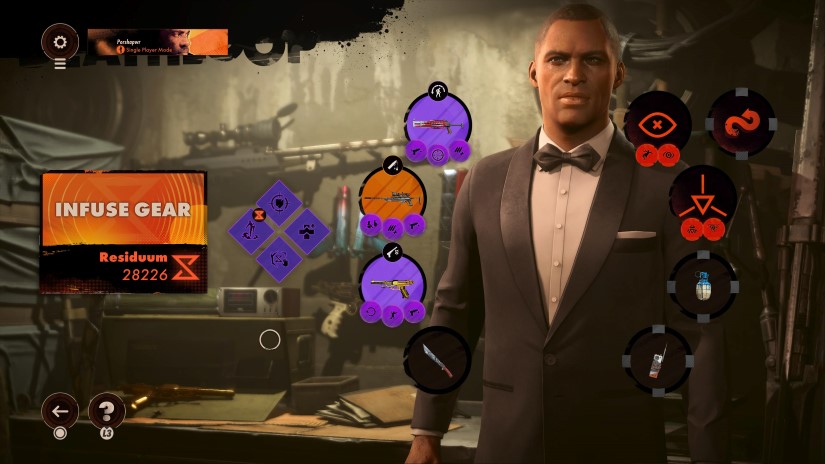
I like the in-game UI sounds for the menus. What went into creating those sounds?
MT: Thank you very much!
I wanted to use a base of vintage technological sounds for this aspect to correspond to the central antenna of the island, which can be seen in several screens of the main menu, such as the time transition screens. And as said above, the radio and glitch sounds already were a binder of our audio art direction. Nevertheless, I didn’t want to copy other games, like Fallout‘s Pip-Boy UI sounds that already use these very well.
I mainly made all the sounds of UI with my electric guitar: the glitches made by the jack wire, harmonics, strings bowed with a double bass bow, electromagnetic sounds recorded with its microphones, etc.
I mainly made all the sounds of UI with my electric guitar: the glitches made by the jack wire, harmonics, strings bowed with a double bass bow, electromagnetic sounds recorded with its microphones, etc.
In addition, I already had composer Tom Salta’s main theme that’s used in menus when I started this work on UI sound effects, so it was enough to play notes of its tonality to help merge the guitar sounds with the music.
This provided a huge quantity of sounds that were almost enough for all the cases needed – and very suited to the “rock ‘n’ roll” music art direction. It only missed bass hits and whoosh sounds that I worked with from audio bank sources or in-house recording.
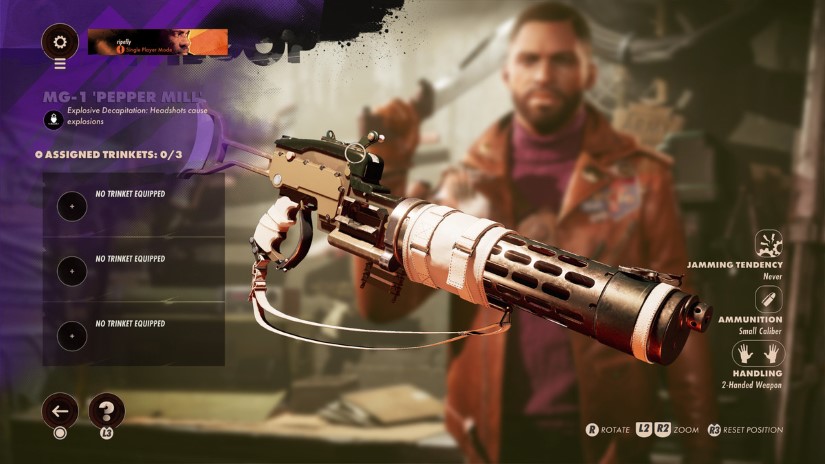
The weapons in the game look very unique. How did you accentuate their visual features in terms of sound?
MT: With Fabien and Thomas, we defined simple guidelines for these weapons made of three main layers.
All the gun animations are rich in mechanical audio details so that we can feel what is happening inside the gun with every reload, jam, empty cartridge, or shot.
First, we wanted to keep a retro feeling because of the late ’60s mood of our game. For this, we accentuated the audio with mechanical sounds being a big part of the mix: metal switches and springs (for weapons like the Strelak Verso, Sepulchra Breteira, and MG-1 “Pepper Mill”), or air pressure sounds (for the Heritage Gun, and PT-6 “Spiker”). We avoided plastic and other materials that are too modern or light. All the gun animations are rich in mechanical audio details so that we can feel what is happening inside the gun with every reload, jam, empty cartridge, or shot.
Secondly, the shots layer has been worked from real sounds of gunshots to bring realism and credibility to our weapons, even for the PT-6 “Spiker” or the Heritage Gun, which are less real-world, with nail ammo for one and glass bullets for the other.
… there is a metal hit at the same time of the gunshot to accentuate the mechanical – and thus vintage – side of the weapon.
And here too, there is a metal hit at the same time of the gunshot to accentuate the mechanical – and thus vintage – side of the weapon. Note that the mix emphasizes even more of these mechanical sounds when in iron sight view, since the ear is closer to the firing pin of the weapon.
Finally, there is additional bass management thanks to extra sub effects throughout, so the weapon gains more or less sound roundness as well as weight. This is our 3rd layer of sound.

All of this was enhanced by the audio HDR and a complex dynamic mix system that allows us to highlight each action according to its gameplay priority and importance in real-time: the number of gunshots, if those come from an NPC or a Visionary or Julianna, if the player’s using a power and if they are running at the same time, etc.
In short, we had a lot of mix rules that allowed us to highlight our big sound design work on the weapons.
We should also mention the excellent work of Benjamin Darmon, a Sound Designer on Arkane’s small audio team, too. He was in charge of all the haptic vibrations, and he adapted sounds of the player and the guns for the PS5 DualSense speaker. It is an aspect of the audio work that we often forget but that considerably adds to the feel of the weapons.
So in the end, there were actually four layers of sound, not three!
[tweet_box]Designing Deathloop’s Grungy, Retro Sound with Audio Director Michel Trémouiller[/tweet_box]
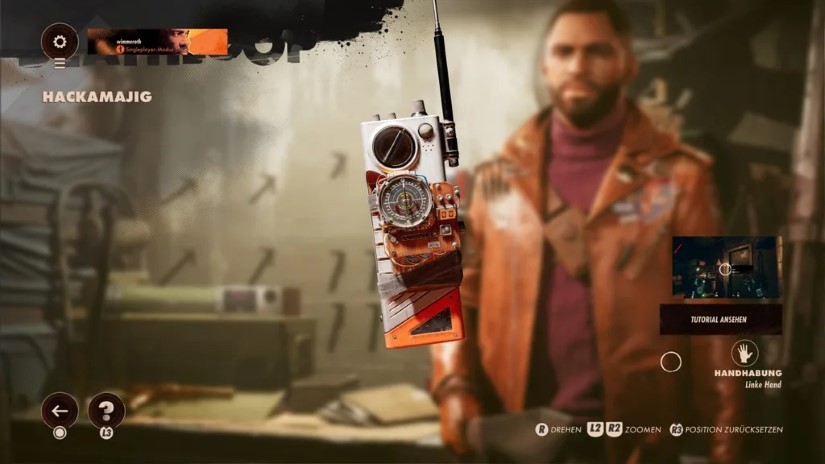
What went into the sound of the Hackamajig?
MT: The Hackamajig has been designed like a gadget in an old James Bond movie. Despite its classy graphic design, we can also notice that there is a part of the device that Colt has tinkered with so it didn’t have to sound like a high-tech device.
…Thomas used radio sounds as if Colt was searching for a station frequency.
To do this, Thomas used radio sounds as if Colt was searching for a station frequency. For all useful audio feedbacks for the player, such as hack validations and failures, we decided to use simple old electronic beeps that sound like an old electronic clock radio. Then, these sounds are filtered so that they have the vintage tone of an old radio speaker. And again, the little mechanical sounds like clocks are very important to helping create the vintage feel of the used technology.
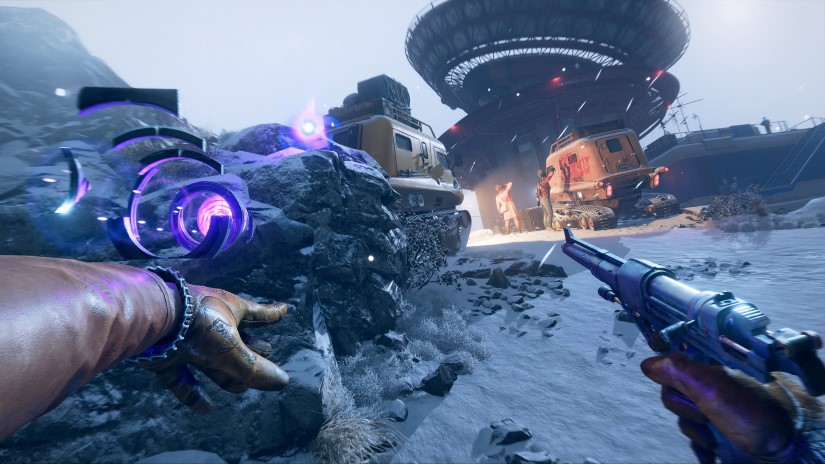
Stealth is an important feature of gameplay, just like in the Dishonored games. It’s important for players to hear the specific directions for where sounds are coming from and moving to? Can you talk about your approach to spatializing sounds in the game?
MT: Deathloop is more action-oriented than the Dishonored games are, but indeed the player can decide to play the game mainly in stealth.
To be as precise as possible with the spatialization, we assigned specific attenuations (radius and properties of the sound emission from a source to the virtual microphone of the camera) for each game feature. Beyond the distance and the volume set in these attenuation parameters, we worked a lot on the EQ setting and the send to the environment reverberation to make everything intelligible at the same time, coupled with complex rules of sound priorities.
To be as precise as possible with the spatialization, we assigned specific attenuations (radius and properties of the sound emission from a source to the virtual microphone of the camera) for each game feature.
For example, a faraway sound of an NPC’s bark is very important to warn the player there is an eminent danger, but it will not be realistic if the player can hear it from too far so we have to cheat and filter it a lot to make it less audible but make it loud enough, and then dynamically cut some other categories of sounds at the same moment. This actually relates more to mix tricks specific to the video game than a particular management of the spatialization.
Moreover, there is the propagation management of the sound: occlusion or reflection of a surface, and the calculation of which path sounds will take in the level according to the obstacles. Even if the Sound Designer checks the result and helps the dev team on it, this part of the audio is especially technical-level work that is handled by the Engine Team. Thanks a lot to Stephane Jeannin, Pierrick Brunet, and Benjamin Charrier for that!
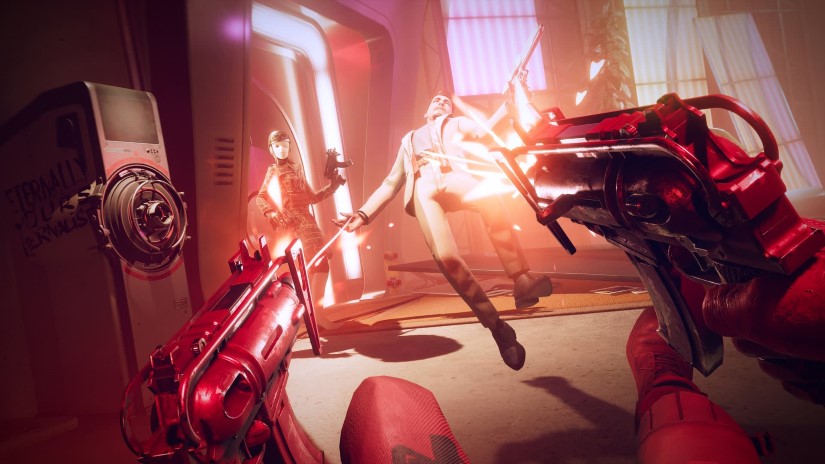
What were some of your technical challenges in terms of game audio? How did you handle them?
MT: Any audio part of a game is a technical challenge!
However, one of our main technical issues was how to adapt our initial middleware routing with the new features that we added progressively during the production, such as the DualSense features, and the HDR mix, which we were not yet very accustomed to at Arkane, or the binaural feature that caused problems if we didn’t want to lose our good native multichannel rendering.
A video game requires constant adaptation because the technology is constantly and quickly evolving along the 4 to 6 years of production needed for a AAA game.
A video game requires constant adaptation because the technology is constantly and quickly evolving along the 4 to 6 years of production needed for a AAA game. It is thus necessary to stay state-of-the-art to offer the best experience to the player.
Moreover, gamers are really demanding on the technological aspect because they want the significant investment they made in a 4K TV and an expensive home cinema or headset to be compatible with the game they are playing. This compatibility can even become the first criteria when choosing a game!
So, we needed to work a lot with audio middleware and our Engine Team, and use ingenuity and agility to introduce all these features along the way.
Fortunately, we had almost no resource constraints thanks to the power of the PS5.
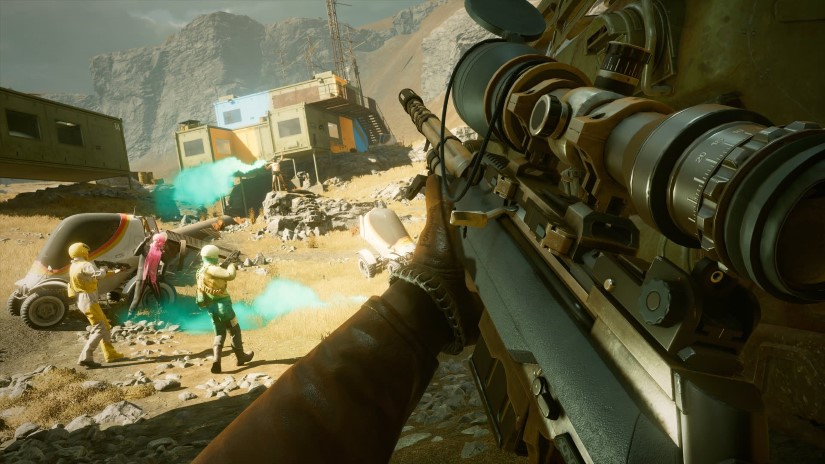
What were your challenges in mixing Deathloop?
MT: There is a big difference between the Exploration/Stealth phases and the Combat or Escape ones since their sound quantity and moods are opposite. Indeed, it’s almost silence versus a huge audio cacophony, which was a big challenge to keep cohesion in the mix without getting too much difference in loudness.
… you must understand the message from a street speaker at the same time as an NPC’s discussion while a nearby speaker is playing Frank Spicer’s songs and another NPC barks to warn that he has spotted you.
We are also very proud of the music and it is very much appreciated by the players. But, it’s mainly saturated psyche-rock with additional orchestral layers so the spectrum used by that already covered a lot of the frequency range and it was sometimes challenging to leave space for sound effects, especially when the combat phases are very frequent. However, I think we did a good job on this, so we don’t regret our musical art direction at all!
Also, we worked hard to make the different layers of speech as intelligible as possible. Indeed, as a player, you must understand the message from a street speaker at the same time as an NPC’s discussion while a nearby speaker is playing Frank Spicer’s songs and another NPC barks to warn that he has spotted you. There are many layers of voices, almost all of them equally important for the gameplay, but it seems that we met the challenge successfully thanks to very elaborate dynamic mixing rules.
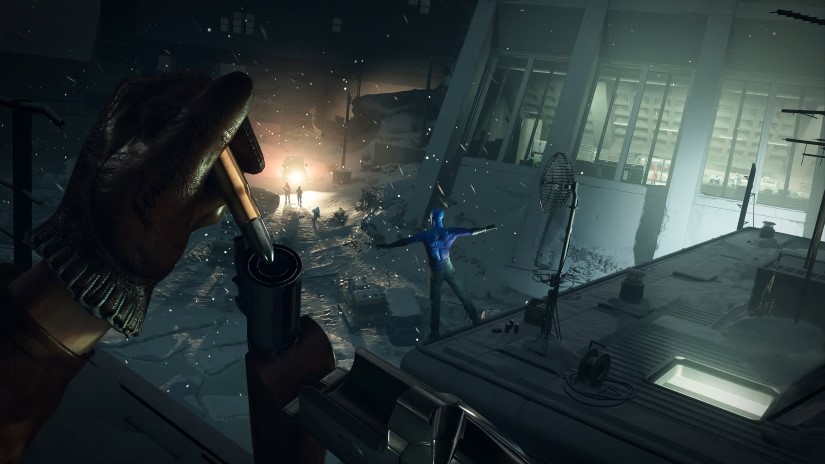
Overall, what are you most proud of in terms of sound on Deathloop?
MT: I’m proud of a lot of things about the sound itself of course, like the weapons and UI sounds, the music integration, some daring technical and aesthetic choices, etc. But as Audio Director, I’m especially proud of the artistic cohesion and unity of the audio despite the choice of spreading a part of each feature through several members of the team.
But as Audio Director, I’m especially proud of the artistic cohesion and unity of the audio…
Usually, there is a Sound Designer specializing in weapons, another on powers, two others focusing on ambiences, etc. But on Deathloop, all the members managed at least one of each feature, and the ambiences were all made collectively. This created more synergy within the team and avoided creative fatigue, while allowing a wider range of sensibilities within each sound category.
Moreover, this has all been done while working from home for almost two years now. Some of our Sound Designers and Marie Chaine (our Audio Producer who helped so much to make all of this possible) had never met in real life until recently.
This is what makes me feel proud of Deathloop in the end.
A big thanks to Michel Trémouiller for giving us a behind-the-scenes look at the sound of Deathloop and to Jennifer Walden for the interview!
 Tesla Model X 2015 electric full size crossover SUV sport utility vehicleKrampfstadt Studio65,00 $0,00 $100% OFF
Tesla Model X 2015 electric full size crossover SUV sport utility vehicleKrampfstadt Studio65,00 $0,00 $100% OFF

